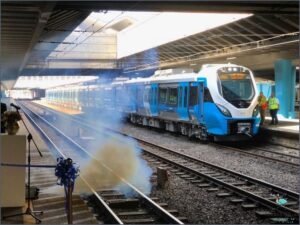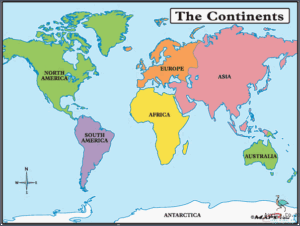
Trains in South Africa are a vital part of the country’s transport network and have been since the 19th century. South Africa’s railway system is one of the largest in the world and is operated by the Passenger Rail Agency of South Africa (PRASA). This extensive railway network links major cities and towns across the country, and provides a safe and efficient form of public transport. PRASA operates a range of services including inter-city and regional rail services, as well as freight services. The network is also used for tourist services, such as the Rovos Rail and Blue Train. Trains in South Africa offer a reliable, affordable and convenient way for passengers to travel between cities and towns. They are a great way to explore the country and its many attractions, and are popular among tourists and locals alike.
Contents
Trains In South Africa
South Africa has a vast and efficient railway system that stretches across the country and has been in operation since the 19th century. The railway network has been divided into two main categories of passenger and freight. Passenger trains are operated by the Passenger Rail Agency of South Africa (PRASA) while freight trains are operated by Transnet Freight Rail. The trains provide an important mode of transport, connecting people to their destinations while reducing traffic congestion. The Gautrain rapid rail link, which connects Johannesburg, Tshwane, and OR Tambo International Airport, is an example of South Africa’s modern and efficient railway system. This system is the first of its kind in Africa and has greatly improved the travel experience within the country. South Africa’s railway system is also connected to that of neighboring countries, making it possible for passengers to travel to other African countries via train.
History of the South African Railway System
South Africa is home to one of the most extensive railway networks in the world, with a history that stretches back to the 1800s. The South African Railways (SAR) system was established in 1873 when the colonial government of the Cape of Good Hope purchased the private railway company, Cape Government Railways (CGR). The CGR had been in operation since 1859, making it the oldest railway system in South Africa.
In the decades that followed, the railway system expanded rapidly and by the early 1900s, the country had more than 5,000 miles of track. This growth was largely driven by the discovery of gold and diamonds in the Transvaal region. The gold and diamond fields necessitated the construction of a network of railways that would link the minefields to the main ports and cities.
The railway system in South Africa was also heavily used during World War I and II, transporting troops and supplies to the battlefields. After the war, the SAR continued to expand, with the introduction of electric locomotives and the construction of a new high-speed line. The new line, known as the Blue Train, was launched in 1923 and ran between Johannesburg and Cape Town.

In the late 1950s, the SAR began introducing new diesel-electric locomotives and streamlined passenger carriages. By the 1970s, the SAR had more than 6,000 miles of track and was the second-largest railway system in the world.
The South African railway system has gone through many changes over the years, but it continues to be an important part of the country’s transport infrastructure. The system is still largely powered by diesel-electric locomotives, but there are plans to introduce electric locomotives in the future. The SAR also continues to be the backbone of the country’s freight and passenger services, providing an efficient and reliable means of transportation for South Africans.
Advantages of Taking the Train in South Africa
Taking the train in South Africa has become increasingly popular in recent years, and for good reason. There are many advantages to taking the train, from affordability to convenience, that make it an attractive option for travelers in South Africa. Here are some of the key benefits you can enjoy when you choose to take the train.
First and foremost, taking the train in South Africa is often more affordable than taking other modes of transportation. Trains are a great way to save money on your journey, as they typically offer discounted fares. This can make taking the train a great option if you’re looking to save money while traveling.
Another major advantage to taking the train in South Africa is that it is often much more convenient than other modes of travel. Trains are typically faster and more reliable than other forms of transportation, making them a great option for those who are pressed for time. Additionally, trains often offer more direct routes than buses or planes, which can save you time and money when it comes to getting to your destination.
Finally, taking the train in South Africa can be a great way to get a unique and enjoyable experience. Trains offer the opportunity to sit back and relax, enjoy the scenery, and get to know your fellow travelers. This can make taking the train a great way to travel, as it can give you a chance to really enjoy the journey.

Overall, taking the train in South Africa has many advantages that make it an attractive option for travelers. From affordability to convenience and a unique experience, taking the train can be a great way to get around South Africa. So, when planning your next trip, consider taking the train – you may be surprised by how much you enjoy the experience.
Challenges Faced by the South African Railway System
The South African railway system is a complex web of interconnected railroads that crisscross the country, connecting major cities and remote rural areas. Unfortunately, the system is plagued by numerous challenges that have made it difficult for the railroads to remain a reliable and efficient mode of transportation. From lack of investment and infrastructure to frequent delays and cancellations, the South African railway system has a long way to go before reaching its full potential.
One of the biggest challenges facing the South African railway system is a lack of investment. Over the years, the government has allocated inadequate resources to the railway system, leading to a lack of upkeep and modernization. The aging infrastructure has caused frequent delays and cancellations, affecting millions of passengers each year. Moreover, the lack of investment has led to a shortage of rolling stock, making it difficult for the railroads to keep up with the growing demand for transportation.
Another challenge facing the South African railway system is the high levels of crime that occur on trains and at stations. This includes robberies, assaults, and other violent acts. The prevalence of crime has severely impacted passengers’ confidence in the railway system, leading to a decrease in ridership. Furthermore, the lack of security personnel and CCTV cameras has made it difficult for the police to identify and apprehend criminals.
Finally, the South African railway system is affected by the country’s economic challenges. As the economy continues to struggle, the government has been unable to provide adequate resources to the railway system, leading to a decrease in services and a rise in ticket prices. This has made it increasingly difficult for the average South African to afford train travel, leading to a decrease in ridership.
Overall, the South African railway system is facing numerous challenges that have prevented it from reaching its full potential. From lack of investment and infrastructure to high levels of crime and economic struggles, the system has encountered numerous obstacles that have made it difficult for it to remain a reliable and efficient mode of transportation. However, with the right investments and policies, the system can be improved and made more accessible to all.
Conclusion
Overall, the South African train system is efficient and reliable. The trains are clean and comfortable, and the staff is friendly and helpful. The train schedule is also very convenient, with trains running regularly throughout the day. The only downside is that the train system is not well-connected to the rest of the country, so getting around by train can be difficult if you’re not familiar with the area.




